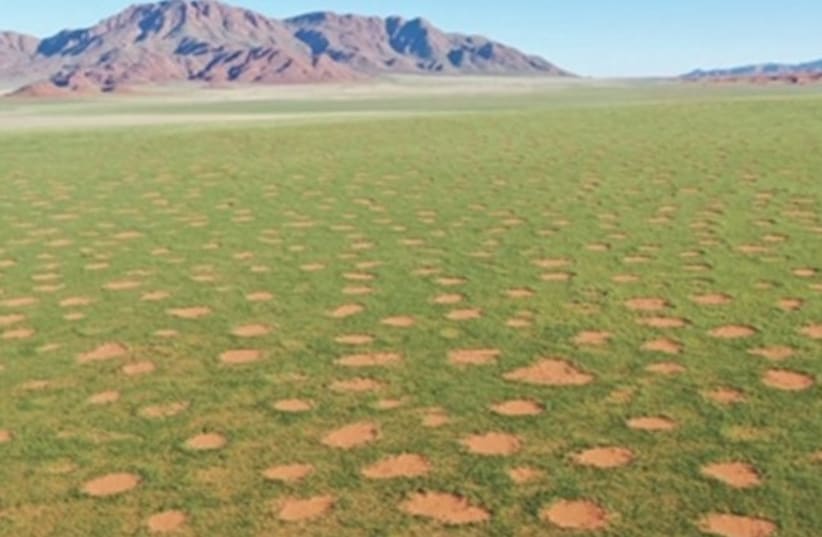Has the missing link explaining ‘fairy circles’ been found?
The myth about dancing gnomes creating them comes from tales derived from Scandinavia, English, Celtic and French folklore.
If you have seen dark patches of grassy ground that produce a circle or partial circle of small mushrooms – usually in autumn – and whimsically believe they were created by fairies or elves, you’re in for a surprise.
The myth about dancing gnomes creating them comes from tales derived from Scandinavia, English, Celtic and French folklore: Fairy rings were mystical gathering places created by dancing fairies and elves, and the mushrooms were convenient dinner tables or resting stools for when they tired. A any human that dared or was lured to enter the ring would be forced to dance until they either went crazy or died of exhaustion.
Some cultures believe that the circles are entrances to another world, while others claim they bring good luck and that they are a sign of an underground fairy village. Long-term observations of fairy rings on a hill in Dorset, England suggested that the cycle depended on the continuous presence of rabbits.
Fairy circles or fairy courts were previously spotted only in the outback of Western Australia or drylands of southern Africa’s Namibia, but more recently, artificial intelligence has been used to identify vegetation patterns resembling fairy circles in hundreds of new locations across 15 countries on three continents. Fairy circles also commonly on golf-course putting greens and less often on home lawns in some countries. The fungi involved produce compounds that reduce the amount of water that the soil can absorb, leading to drought conditions that cause the grass in the ring to brown and die. During wet weather, rings of mushrooms may form at the edge of the discolored grass.
There are three types: when the thatch and soil are very dry and repel water; when rings or arcs of turf appear that are dark green and grow faster than the surrounding turf; and when mushrooms or puffballs are produced in a ring or arc.
Theories for their appearance range from spatial self-organization induced by scale-dependent water-vegetation feedback to pre-existing patterns of termite nests.
Solving the mystery of fairy circles
Now, after years of research and unsatisfactory alternative explanations, physics Prof. Ehud Meron and colleagues at Ben-Gurion University of the Negev (BGU) in Beersheba believe that pairing spatial patterning and phenotypic changes provides the answer. Meron teaches and does research at BGU’s Blaustein Institutes for Desert Research and the physics department. His recent work has involved collaborating with ecologists in an effort to assimilate the concepts of pattern-formation theory into ecological research.
The team has been studying the Namibian fairy circles as a case study for understanding how ecosystems respond to water stress. He believes that all theories to date have overlooked the coupling between two robust mechanisms essential for understanding ecosystem response – phenotypic plasticity at the level of a single plant and spatial self-organization in vegetation patterns at the level of a plant population. Phenotypic plasticity is the plant’s ability to change its own traits in response to environmental stresses.
Together with postdoctoral fellows Dr. Jamie Bennett, Dr. Bidesh Bera, and Dr. Michel Ferré and his colleagues, Profs. Hezi Yizhaq and Stephan Getzin, they propose a novel model that captures both spatial patterning by a scale-dependent water-vegetation feedback and phenotypic changes involving deep-root growth to reach a moister soil layer.
By comparing model predictions with empirical observations, they show that the coupling between these two mechanisms is the key to resolving two outstanding puzzles that the classical theory of vegetation pattern formation fails to explain – the appearance of multi-scale fairy-circle patterns, where the matrix in between the fairy circles consists of small-scale vegetation spots and the absence of stripe and spot patterns, besides gap patterns, along the rainfall gradient, as the classical theory predicts.
They also found that the combination of plant-level phenotypic changes and population-level spatial patterning can result in many additional pathways of ecosystem response to water stress, resulting in different multi-scale patterns, all of which are significantly more resilient to water stress than those involving a single phenotype.
Their findings have just been published in the journal Proceedings of the National Academy of Sciences (PNAS) under the title Phenotypic plasticity – a missing element in the theory of vegetation pattern formation.”
Identifying these alternative pathways is essential for shifting fragile ecosystems on tracks to collapse to pathways of resilience,” explained Meron, who recently won a European Research Council’s ERC Synergy Grant to study resilience pathways in drylands and other biomes. “This study highlights the importance of considering more elements of ecosystem complexity when addressing how to evade tipping to dysfunctional ecosystem states as warmer and drier climates develop,” he concluded.



No comments:
Post a Comment
Stick to the subject, NO religion, or Party politics